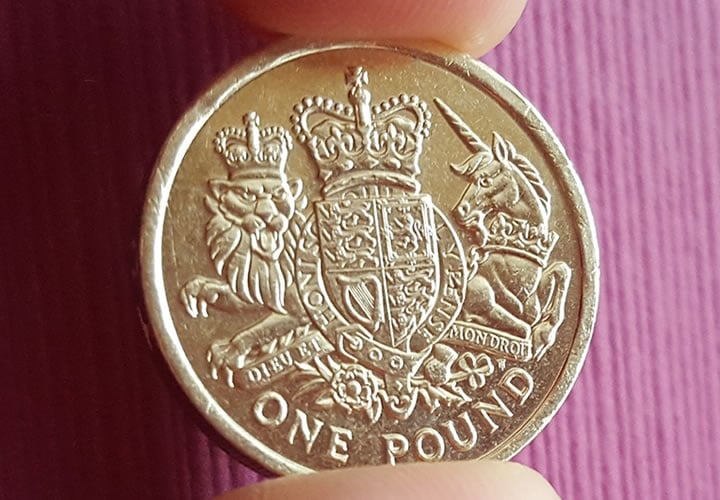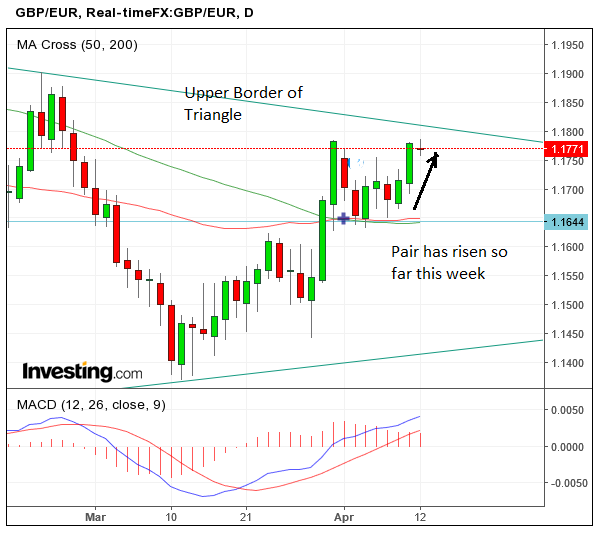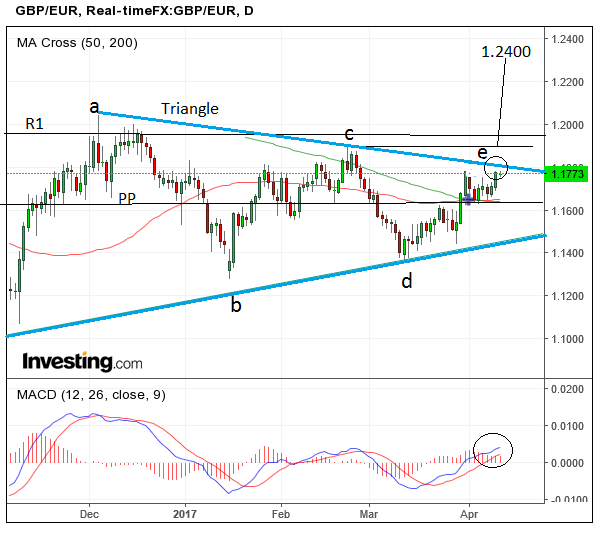Pound hits Our €1.18 Target, €1.20-1.21 Could be Next

The Pound to Euro exchange rate has today achieved a new one month-high against the Euro as per our expectations communicated ahead of the start of this week.
In our week-ahead series we forecast that GBP/EUR would extend its short-term rally and achieve an initial target at 1.1800 based on our various technical studies.
Further gains above 1.24 are also envisaged but the probability of such a move is understandably less assured on longer-term timeframes.
The call for an initial target at 1.18 has been proven right after the pair rallied from the 1.1680s to a peak of 1.1806 on Thursday, April 13:

So what does the outlook for GBP/EUR from here look like?
If the pair goes any higher we believe it may stall at around 1.1800, which is the level of the upper border of the symmetrical triangle pattern.
This is likely to prove difficult to breach due to incoming supply from traders selling the pair at this level.
As such a pause is expected ahead of a break higher or a fading of strength and a shallow retracement back into the early 1.17's takes place.
The Pound to Euro exchange rate rate is currently in a wave-e of the triangle, which normally have five component waves (a-e), therefore, this could be the final wave.
If it is, there is a high chance of a breakout higher once the wave finishes.
A break above the late February highs of 1.1903 would provide confirmation of a complete breakout from the triangle, although the market may provide earlier entry points too – we will be monitoring and reporting on the situation as it unfolds.
Momentum, as measured by the MACD in the bottom pane is also constructive, marginally supporting an upside breakout.

The R1 monthly pivot - a level calculated from the previous month’s high, low, open and close – is at 1.1920 and could provide some resistance to more upside, but once the breakout from the triangle has been confirmed buyers may swamp the market propelling the exchange rate rapidly and forcefully higher – possibly straight through R1.
Robin Wilkin at Lloyds Bank tells us the EUR continues to show mild under-performance but GBP/EUR is now testing triangle resistance in the 1.1813 region.
Wilkin says a break through here may see the Euro’s under-performance pick-up allowing GBP/EUR to re-test the more important resistance in the 1.2048-1.2121 region.
Alternatively, the pair could rotate at the level of the upper border and fall, breaking out to the downside instead, since this is a symmetrical triangle and these do not offer any clues as to the direction of the final break.
Pound’s Outlook Challenged as UK Wage Growth Outpaced by Inflation
Ahead of the Easter weekend, the latest news from the UK economy has not benefited Sterling as it points to a slowdown in growth over coming months.
The ONS reports that wage growth in the UK is now at 2.2% and is therefore below inflation which is running at 2.3%.
This implies that the squeeze on living standards is intensifying and this is bad news for an economy that has long been dependant on consumer spending.
The Bank of England will look at this data and most likely conclude the need to implement a pro-Sterling interest rate rises is not yet justified.
Furthermore, data on hours worked shows the extra hours being put in by UK workers are not necessarily commanding higher wages.
“There has been a relative shift away from large-scale hiring and towards using existing workers more intensively. It is suggestive of firms standing still, putting to work existing staff more intensively for unchanged – or weaker – pay growth,” says Daniel Vernazza, UK Economist at UniCredit Research in London.
However, one would imagine there is another way of looking at the graph in that it potentially signals a pick up in wages in the future as extra hours worked will ultimately have to be met with wage rises in the future.
“We remain optimistic that the decline in labour market slack will feed through into at least some pick-up in nominal wage growth. In any case, consumer spending should be supported by strong confidence, jobs growth, and supportive credit conditions," says Paul Hollingsworth, UK Economist at Capital Economics.
If this is correct then the Bank of England might have to anticipate rising wages will lead to higher inflation in the future which could prompt talk of an interest rate rise.
This would be positive for Sterling on a longer-term basis.
However analyst Robert Wood at Bank of America Merrill Lynch Global Research says the lack of wage pressure in the UK confirms there is still plenty of slack in the labour market.
Wood believes productivity growth in the UK remains desperately weak and this, along with the slowing workforce growth evident in today's data, are two reasons why BofAML are pessimistic about UK trend growth, they peg it at 1.25%.
"With domestically generated inflationary pressure conspicuous by its absence, both in yesterday's inflation data or today's wages numbers, the Bank of England can, in our view, continue to data-watch rather than more aggressively agitate for rate hikes," says Wood.
Watch the News Headlines - Sterling is a Risk-on / Risk-off Play
It appears that the big driver of the Pound at present is geopolitics and as such any impact to the UK currency from the data report could be muted.
As we noted here, the Pound was a major beneficiary of a spike in nervousness amongst the investor community over the course of the past 24 hours.
The British Pound to Euro exchange was last quoted at 1.1785 having achieved a day's high of 1.1793 while the day's low was registered at 1.1756.
There are two geopolitical fronts investors will be watching over coming hours.
The US administration is increasing pressure on the Russians over their support for Syrian President Assad on one front, while pressuring North Korea on another front.
The North Korean situation is arguably more volatile owing to the unpredictability of the regime in Pyongyang.
However, Trump too continues to brandish his own style of unpredictability.
Trump tweeted on Tuesday, “North Korea is looking for trouble. If China decides to help, that would be great. If not, we will solve the problem without them! U.S.A.”
The move caught markets by surprise.
“The Yen surged on geopolitical tensions. The ever-hot twitter account from Trump dampened the risk sentiment as he tweeted “North Korea is looking for trouble”. Dollar was mixed. The Pound was also stronger for the same driver as the Yen,” notes Holger Sandte, an analyst with Nordea Markets.
Sandte points to an important dynamic in which the Pound is actually being favoured in conditions where markets are nervous.
We have mentioned that the UK is looking to be more of a safe harbour with elections in France just around the corner.
Markets have shown increased nerves towards European assets as far-left candidate Jean-Luc Melenchon muddies the playing field and creates a scenario where any one of the main four candidates can now win.
The US Dollar is also not finding its traditional safe-haven characteristics as investors buy safer US bonds which in turn sends the yield on those bonds down which lowers support for the Dollar.
The Pound has long been associated with risk as the uncertainties regarding Brexit loom large ahead - but these risks are well flagged and markets have had months to position accordingly.
So with the Pound being a winner in times of increased risk sentiment, it goes that it will likely be a loser if the situation settles down.
Save
Save
